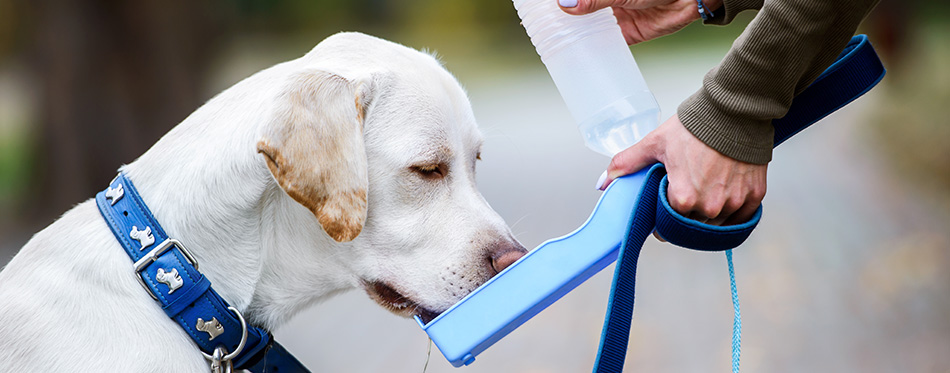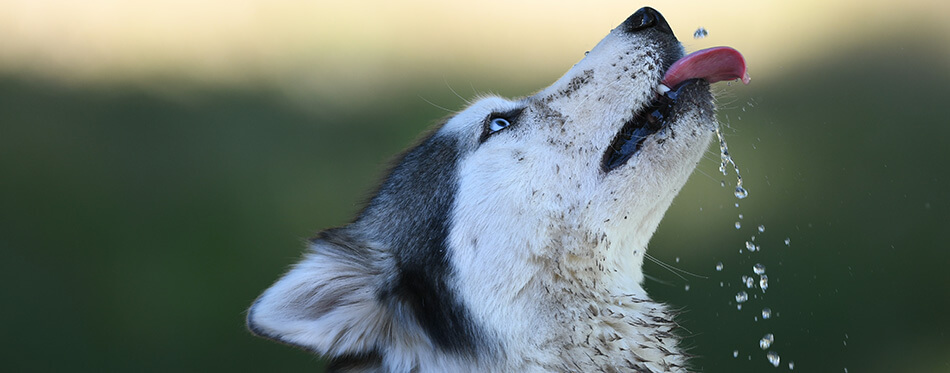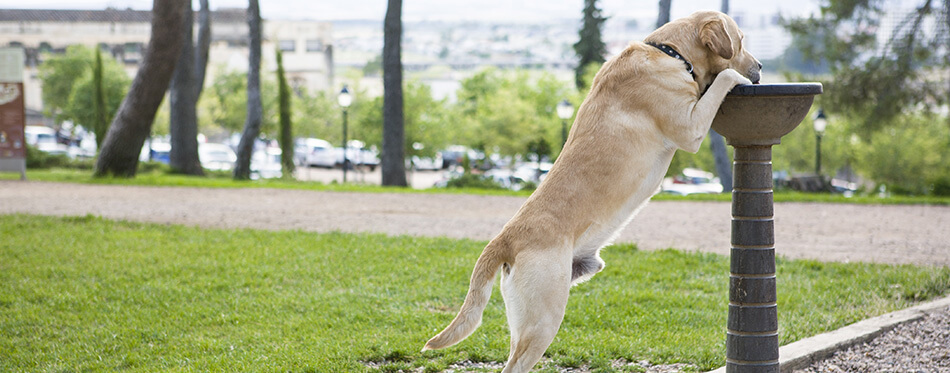As we stroll leisurely into Fall and Winter you may believe the risk of dehydration is low now the warmer months have moved on, however, it is important to understand that there are other factors that could cause dehydration in dogs.
Whether you’re simply and innocently curious, forgot to fill your dog’s water bowl this morning, or you’re worried there might be a problem with your fur friend we have the answers to the question above and some further information to help you prevent dehydration to keep your dog in good health.
Why Water Is Important For Your Dog
Did you know that your dog is composed of 80% water, and like humans, dogs need to drink a certain amount of water a day to be healthy? Water is essential for the survival and wellbeing of almost all living beings and it is responsible for carrying all of the essential nutrients through your dog’s body.
The regular consumption of water will have an impact on your dog’s brain activity, temperature regulation, digestion, joint lubrication, and many other things that contribute toward a healthy dog. A slight decrease in the water composition of your dog’s body will leave it dehydrated which can have serious consequences on your dog’s health.

How Long Can Dogs go Without Water?
There are a number of things to consider when it comes to canine dehydration. The length of time a dog can last without water can vary depending on breed, age, body weight, and size however typically healthy dogs can last up to three days. Sick dogs, however, may survive less.
In addition to this, you may want to take note of other factors that might contribute towards how long a dog can last without water such as, hot weather, how active they are, and if they are eating wet dog food. Eating wet food could extend the amount of time a dog could survive but it is not a substitute for drinking water.
How long can a puppy go without water?
Being the owner of a puppy can be stressful and worrying at the best of times without being concerned over their water intake. Depending on their activity levels and size a puppy may drink more or less than adult dogs but in their earlier years, they will depend more on their mother’s milk before they are weaned and go on to eat solid food.
After Weaning
Eventually, when your puppy is weaned and begins to consume solid foods, it will be necessary to monitor how much water they drink daily. Due to the gradual shift in diet, it is important that they have access to a freshwater supply and drink about half a cup of water every two hours.
How Long Can a Dog go without Food?
Your dog can sometimes refuse to eat food for the same reasons they refuse to drink water. However, if your dog suddenly stops eating it is usually seen as a bigger cause for concern as the food holds a lot of vitamins and minerals. In regards to this, a healthy dog can actually last up to months without eating if they have access to water but you should still seek advice from your vet if this should occur.
What Can Cause Dehydration in Dogs?
It is uncommon that your dog will deprive themselves of clean, freshwater, yet on the occasion that they should refuse to drink, it is important to understand some of the reasons why they may be doing so.
The list below may seem daunting if you’re wondering ‘why won’t my dog drink water?’, but paired with the factors in your home, you may be able to successfully narrow down a potential reason why your dog won’t drink. Using this information you can always consult with your local vet to get the care your dog needs should the issue get worse.
Health Issues or Illness
A dog may refuse to drink water because of any pain or discomfort it may be feeling. The refusal may also be because of an ongoing illness that will cause your dog to dehydrate quicker. An ill dog suffering from metabolic disorders, cancer, or kidney disease is at risk of dehydrating quicker than a healthy dog.
Vomiting and Diarrhea
As a dog owner, these two conditions can be worrying for several reasons but be aware that these may result in a severely dehydrated dog due to the loss of water. A sick dog may still want to eat and drink water despite these conditions so always make sure they have access to their water bowl and have a highly digestible diet.
A Sore Mouth
If your dog enjoys the back and forth of fetching it is entirely possible that they are experiencing a sore mouth if they have a special love for sticks. The constant friction of wood on their mouth could leave them with sores and it is common for splinters to even cut their tongue throughout excessive playtime. It is also likely that they may also stop eating their food for fear of irritating their mouth further.
Diet
When your dog refuses water it could be due to their existing diet. Most dogs that consume canned dog food or a homemade diet get a lot of moisture from these foods and will rely less on drinking water. You may notice that a dog who is accustomed to dry food will drink water more than a dog that eats wet food.
Salty Foods
Feeding dogs salty foods can also have an impact on their health and hydration. Check to see that you’re not feeding your dog meals high in salt frequently as this can lead to severe dehydration as well as high blood pressure and generally poor health.
Lack of Access
Those pet owners with bigger homes can forget about the access their pets may have to freshwater. Having numerous water bowls during hot weather around your home will encourage your pup to drink more so that they can regulate their body temperature better.
Crate-Trained Dogs
Your dog may also struggle to drink water if they are crate trained, especially if they spend a lot of time within their crate. If there is a water bowl inside it, and it’s likely your dog knocks it over, you can purchase weighted water bowls and even bottles specifically designed to attach to the space. For more options head over to our guide on dog crates.
Hot and Cold Weather
During the warmer weather, dogs drink water to maintain or regain normal body temperature. This is also because your dog tends to lose a lot more water than in the cooler months because of the heat.
However, as the weather becomes increasingly colder they will be less likely to drink water, leaving your dog dehydrated. Your pup may also be less likely to drink due to the decline in the temperature of the water however, there are dog water bowls specifically designed for the colder weather so you can hydrate your dog safely.
Fussy Drinkers
Whether your dog will drink water can also boil down to its behavior and nature. Some dogs don’t drink water as frequently as others as they may not burn as much energy or simply not need as much in general.
Another reason why your dog may not drink as much is its water bowl. Believe it or not, dogs may not like the material of the water bowl or even its shape or size. As dog owners, this may be rare and a little irritating should you have to try different bowls in order to get them to drink more, but the important thing is to keep them healthy and hydrated.
Trauma
Surgeries such as neutering or dental procedures can have your dogs stop eating due to the shock of the experience. However, this occurrence should be temporary. This advice will usually have you showering them with your undying love amongst other helpful tips to make your dog feel safe.
Anxiety
Somewhat similar to experiencing trauma, your dog can also exhibit signs of anxiety which can mean your dog eats and drinks less due to feeling nervous. Anxiety can occur for a number of reasons such as if their living environment changes, after the loss of a household member, or even if they visit an unfamiliar area. However, there are plenty of things you can do to resolve this, including talking to your vet.

Dehydration Warning Signs
If you’re worried about your dog becoming dehydrated there are plenty of steps you can take to prevent this once you can identify the warning signs. As a responsible dog owner, monitoring how much they drink is the first step in identifying a potential problem.
If you notice that you’re finding yourself refilling their bowl with waterless and less, you should turn your attention to how your dog is behaving and observe any changes in their physical condition. Fortunately, these signs can often be quite obvious when you start looking.
Reduced Appetite
This is one of the initial signs of dehydration. Healthy dogs will wolf down their meals whereas a dehydrated dog will find it difficult to swallow and digest food. Eventually, they will lose interest in their meals and not even attempt to nibble.
It is also important to understand that a reduced appetite may cause your dog to become lethargic. As a result, this means that there is less blood flowing through your dog’s body to fuel their muscles to encourage movement and activity.
Sunken Eyes
Dehydration can also impact your dog’s eyes leaving them sunken. The lack of water will result in the muscles surrounding the eyes being unable to support them.
Dry Nose and Gums
A dog’s nose should be wet if they are happily hydrated and drinking water regularly. However, if they appear to have a dry nose it may be time to get some advice. Left untreated their nose may become cracked due to the lack of moisture.
Dogs should also have wet pink gums so check to see what color they are and how dry their mouth is. It is not uncommon for a dog’s mouth to become dry, as most dogs sleep with their mouth open, although, if their gums are particularly pale and their mouth is consistently dry this may be a sign of dehydration.
Low Skin Elasticity
A dog’s skin, if gently pinched will almost immediately resort back to its original position whereas a dehydrated dog’s skin will take a little longer to fall back into place.
Excessive Panting
If you find that your dog pants excessively this could be due to a lack of water. A dog pants to indicate a rise in body heat and that they may be thirsty. Access to a dog water bowl will usually reduce panting and increase their hydration.
The Effects Of Dehydration
Understanding the signs and causes of dehydration can save a dog’s life as without water, a dog’s digestive system, organs, and joints will suffer. A significant amount of time without water will lead to death.
Tips to Prevent Dehydration in Dogs
Moving away from the previous worrisome heading we have a number of tips to prevent your dog from becoming dehydrated. Whether they are forgetful, fussy drinkers, or active dogs, we have here a list of things to consider when getting your dog to drink more.
Alternative Dog Food
If your dog is used to dehydrated dog food then a good alternative is canned food as it is high in moisture. This will improve your dog’s hydration and health if you find that they are not drinking water enough.
Hydrated food is also a good switch for dog owners whose pets are recovering from surgeries or illnesses when they require a little extra hydration. Though they may still be in the habit of drinking water regularly they may need something extra to help them recover faster.
Flavoured Water For Fussy Drinkers
Cats aren’t the only pets that can be picky with their foods at times. If you should find that your dog doesn’t drink their water specifically because they don’t like the taste, you can add a little flavor to encourage them to drink more!
Some dog owners have added a teaspoon of chicken or beef broth to their dog’s water bowls to entice them into drinking more. Others have added ice cubes to the water bowl or have been careful to use filtered, distilled, or tap water as even people have agreed these all have differing tastes.
Numerous Water Bowls
Making sure your dog has access to more than one bowl of water can increase your dog’s water intake, especially if you live in a larger home. It may also be a good idea to have one outdoors on warmer days to encourage your dog to drink when they’re having fun outside.
Tips for Keeping Hydrated on Long Walks
During long walks, it’s always a good idea to bring water specifically for your dog as the increased activity will mean that their temperature will increase. Having a handy water supply for them will keep them cool and hydrated.
Keeping Your Dog Hydrated While Traveling
You may be wondering how long can a dog last without water on a long journey which can be answered with the questions leading into this section. However, it is recommended to have a water supply for your pooch should they show signs of thirst such as panting. It’s better to be safe when taking your dog on a long journey so keeping water for them is a must.

How Much Water Should Dogs Drink?
Generally, your dog should be drinking one ounce of water per pound of their body weight a day. This would mean that a 40-pound dog should drink around 40 ounces of water a day. Although, calculating the exact amount of water to the ounce that your dog should be drinking isn’t particularly necessary when monitoring their intake. Generally, as stated above, the intake can depend on their size, body weight, and activity levels.
For example, if your dog has been challenging the record number of laps run in your yard, they will drink an enormous amount due to the energy they’re burning. In terms of size and breed, small dogs will often need less water than larger dogs due to their smaller size.
Therefore, it is merely enough that you make sure that they are getting enough water to sustain their lifestyle and that there are no mitigating symptoms that could suggest an illness or dehydration.
Excessive Drinking
Alternatively, if your dog is drinking a larger amount of water than normal it could be a sign of underlying conditions such as Cushing’s disease, diabetes, or kidney failure. These illnesses could be the reason behind the loss of water your dog is experiencing but it is important that you seek advice and understanding from your vet.
In addition to this, another reason for your dog’s large water consumption could be psychogenic polydipsia. This condition is an uncommon behavioral one that can occur in bored puppies or breeds that love filling up on water.
What to Do if Your Dog is Drinking a Lot
Never restrict the amount of water that your dog has access to as this could lead to dehydration and other serious illnesses. You should always see a vet if you are concerned as this could lead to the diagnosis of any potential underlying conditions.
So, How Long Can a Dog Go Without Water?
How long can a dog go without drinking water shouldn’t be a question that you ask yourself more than once. The answer to the question is generally around three days if they are of a healthy build and weight, though always make sure they have access to a fresh supply.

